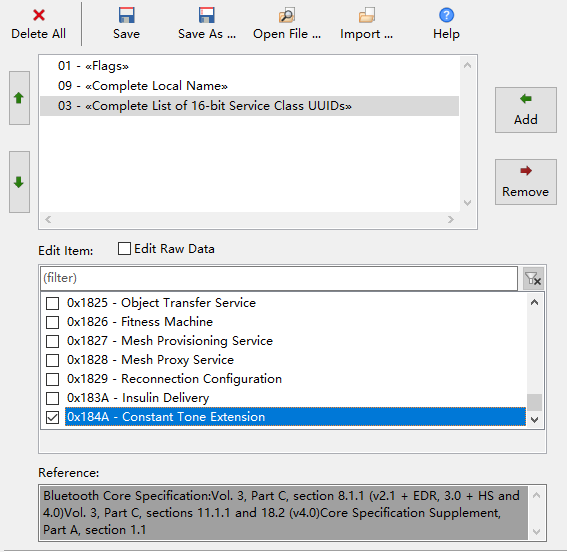5 SDK Support of Direction Finding
SDK supports four types of CTE solutions, two are defined by Bluetooth SIG in Bluetooth Core Specification, and the other two are INGCHIPS proprietaries.
5.1 Types of Solutions
5.1.1 Connection Based Solution
Connection based solution is defined by Bluetooth SIG. A connection must be established between two partners, and then CTE signals are sent upon the requests from a central device. This is demonstrated in Peripheral LED & CTE and Central CTE.
In Peripheral LED & CTE’s advertising data, the availability of CTE service is broadcasted (Figure 5.1).

Figure 5.1: Advertising of CTE Service
There is an Enable characteristic in CTE service. A GATT client should set it to true before
requesting the peripheral to send CTE.

Figure 5.2: Service Definition of CTE
5.1.2 Connectionless Solution
Connectionless solution is also defined by Bluetooth SIG. The CTE transmitter sends CTE in a periodic advertising set. The receiver has to establish synchronization with the periodic advertising set firstly, and then CTE can be received. This is demonstrated in Periodic Advertiser and Periodic Scanner.
5.1.3 Proprietary Solution #1
This is based INGCHIPS BLE extension APIs, and provides lots of flexibilities, such as:
- More bits in IQ samples (all bits from RF can be utilized)
- More samples within a single sample slot
- Full control over access address, CRC initialization value for privacy
- Full control over channel selection
Read Programmers’ Guide on Bluetooth Low Energy6 for more information.
5.1.4 Proprietary Solution #2
This type tries to provide compatibility of Silicon Labs proprietary AoA7, which sends CTE in extended advertisements. This is also demonstrated in Peripheral LED & CTE and Central CTE.
Compatibility status:
- A tag sending CTE with proprietary direction finding #2 can be received by Silicon Labs AoA locator
- A tag sending CTE with Silicon Labs proprietary AoA can be received by INGCHIPS AoA locator if the least significant byte of the tag’s device address (no matter if it is a public or random address) is 0x14 or some other proper values.
5.2 Recommendation
It is strongly recommended to use proprietary direction finding solution, because of several shortcomings in the two Bluetooth SIG defined solutions:
Scalability
Both of the two Bluetooth SIG defined solutions do not scale very well: devices can’t support lots of connections or periodic advertising synchronizations simultaneously.
Latency
Both of the two Bluetooth SIG defined solutions have pre conditions before the reception of CTE, which is time consuming, especially in the case of connectionless solution.
Robustness
In the case of connection less solution, it’s rather difficult & tricky to keep synchronization with several periodic advertising sets.